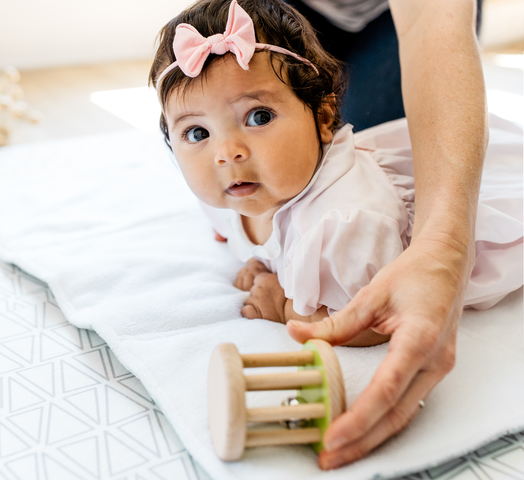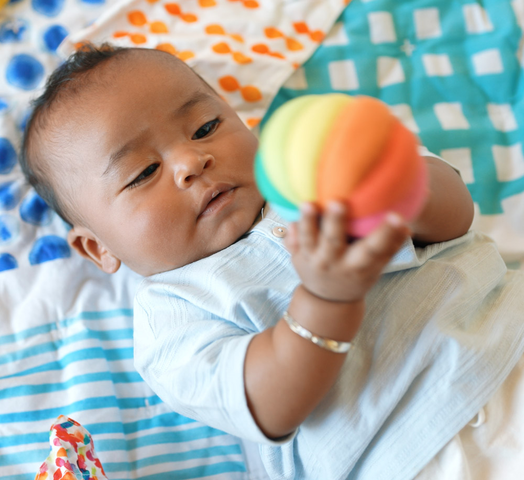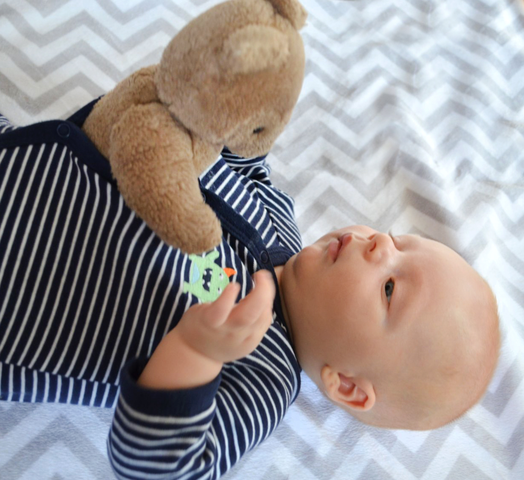Baby Milestones & Play Ideas for 3-4 Month Olds
Parents tend to notice (or stress about) the big baby milestones, the ones you check off at the pediatrician’s office - rolling, crawling, sitting, standing, walking. But for weeks and months before you see those exciting skills, babies are practicing “mini-milestones” - the subtle little skills which are the building blocks of big milestones.
Your baby practices these smaller skills during playtime with people, playthings, or both. Through their stage-based Play Kits, Lovevery focuses on these mini-milestones in each area of development .
NOTE: Most parents think in terms of weeks/months when it comes to milestones and so that is how this post is titled. However, each kiddo travels their own individual developmental path - none is right or wrong. Our job as parents and mine as a professional is to support that individual path and enlist help when needed to do that. If your kiddo isn’t displaying this pre-rolling mini-milestone at 3-4 months, notice what they ARE working on and play to those movements and skills. Ask a developmental provider for support if you feel like you need it.
Let's look at one particular mini-milestone that is a building block of rolling back to belly using items from The Charmer and The Senser Play Kits by Lovevery:
A Little Known 3-4 Month Milestone
In the months leading up to baby learning to roll back to belly, most will begin working on tucking their chin toward their chest - what child development nerds like me call "neck flexion.”
I get excited when I see a baby starting to flex the neck because it means exciting ways to play (a.k.a. happily and naturally learn, grow and develop) with hands and feet may be coming soon: using both hands above the chest to manipulate a toy like the Hand-to-Hand Discs and looking toward and eventually grabbing lifted feet.
The chin tuck movement seen in all these ways to play requires neck strength and flexibility and will become one of the initial movements your little one will likely use to initiate rolling.
Developmental Play For Your 3-4 Month Old
When you start to see this chin tuck, it’s a great time to begin to include some active belly-up play activities in your baby's play stations that involve looking down toward the chest, belly or feet. Here are some ideas:
Foot Rattles With Towel Roll Under Bottom
By rolling a towel to lift the hips a bit, you may be able to help your little one see their feet with Play Socks or foot rattles on them. You could also achieve the same effect by propping baby's feet against your body or against a soft chair or thick nursing pillow.
Singing, Talking, and Kissing Baby
You see this on many “how to play with baby” lists, but strategically positioning your body and face above baby’s feet so they begin to gaze downward to see you gives them sensations of a new head position and makes this activity new all over again!
Strategic Toy Placement On Baby's Activity Gym
If you've read CanDo Kiddo + Family for long, you know I love The Play Gym by Lovevery and frequently recommend strategic toy placement to help promote head turning in babies (to help prevent Flat Head Syndrome / Plagiocephaly and Torticollis).
When you start to see some chin tucking, start hanging toys over your baby's belly and feet. Not only will they have great opportunities to practice tucking their chin, they'll also likely start working on bringing hands together and kicking their feet - other important skills often seen around this stage.
A Toy On Baby's Chest
Placing a soft toy on baby's chest can hold their attention for quite a long time at this stage. If your baby has emerging use of two hands together, a toy that requires two hands to grasp, like the Rainbow Ball, offers great practice (bonus: the Rainbow Ball also stimulates baby’s emerging color vision). If your little one wears sleepers with snaps, you can try my trick of snapping a stuffed toy to hold it in place (see photo below).
Balloons
This is one my favorite activities! Clip or tie a mylar balloon to baby’s foot and gradually lower to challenge baby to chin tuck. You can also tie or clip a balloon to a doorknob or piece of furniture and position baby on their blanket with feet pointing toward balloons.
You must CLOSELY SUPERVISE this activity (eyes on baby within arm's reach).
Reflection:
When you think about your baby achieving milestones “on time” according to developmental checklists or resources, how do you feel - excited, proud, relieved?
When you think about your baby achieving milestones “early,” how do you feel - impressed, reassured, proud,…?
What about your baby achieving milestones “late,” how do you feel - do you feel worried, guilty, pressured, embarrassed?
All feelings are okay. No answer you could give to these questions is wrong. But it is such a powerful exercise to examine what we are making milestones mean. Believe it or not you can choose to change your thoughts about a milestone that might not be achieved when you expected it to be. And it can really change the lens through which we observe our babies to remember that each baby is an individual unfolding on their own unique developmental path. I appreciate Lovevery’s emphasis on encouraging your baby’s discovery through play. Their Play Kits and accompanying Play Guides help boost many parents’ confidence and enjoyment of baby development.






